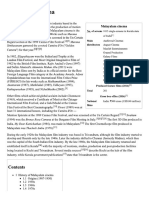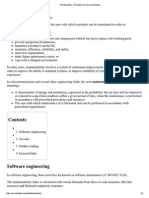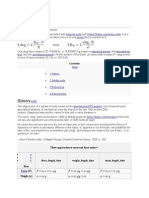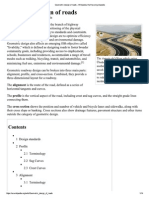0 ratings0% found this document useful (0 votes)
222 viewsSoftware Development Process
Software Development Process
Uploaded by
Bobby Walterssoftware
Copyright:
© All Rights Reserved
Available Formats
Download as PDF or read online from Scribd
Software Development Process
Software Development Process
Uploaded by
Bobby Walters0 ratings0% found this document useful (0 votes)
222 views11 pagessoftware
Copyright
© © All Rights Reserved
Available Formats
PDF or read online from Scribd
Share this document
Did you find this document useful?
Is this content inappropriate?
software
Copyright:
© All Rights Reserved
Available Formats
Download as PDF or read online from Scribd
Download as pdf
0 ratings0% found this document useful (0 votes)
222 views11 pagesSoftware Development Process
Software Development Process
Uploaded by
Bobby Walterssoftware
Copyright:
© All Rights Reserved
Available Formats
Download as PDF or read online from Scribd
Download as pdf
You are on page 1of 11
siez01s Software doveloomert process - Wikipedia, tho fro encyclopedia
Software development process
From Wikipedia, the free encyclopedia
In software engineering, a software development methodology (also known as a system development
methodology, software development life cycle, software development process, software process) is a
splitting of software development work into distinct phases (or stages) containing activities with the intent
of better planning and management. It is often considered a subset of the systems development life eycle.
The methodology may include the pre-definition of specific deliverables and artifacts that are created and
completed by a project team to develop or maintain an application.!"]
Common methodologies include waterfall, prototyping, iterative and incremental development, spiral
development, rapid application development, extreme programming and various types of agile
methodology. Some people consider a life-cycle "model" a more general term for a category of
methodologies and a software development "process" a more specific term to refer to a specific process
chosen by a specific organization. For example, there are many specific software development processes
that fit the spiral life-cycle model.
Contents
1 In practice
2 History
3 Approaches
"5.1 Waterfall development
3.2 Prototyping
3.3 Incremental development
3.4 Iterative and incremental development
3.5 Spiral development
3.6 Rapid application development
3.7 Agile development
3.8 Code and fix
3.9 Lightweight methodologies
3.10 Other
Ipsilon wikipotiaorgik’Sotware_ development process
wm
iez01s Software doveloomert process - Wikipedia, tho fro encyclopedia
4 Process meta-models
5 Formal methods
6 See also
7 References
8 External links
In practice
‘A variety of such frameworks have
evolved over the years, each with its
own recognized strengths and Prototyping
weaknesses. One software
development methodology
framework is not necessarily suitable
for use by all projects. Each of the
available methodology frameworks Spiral
are best suited to specific kinds of Analysis | Evalu
projects, based on various technical,
organizational, project and team Waterfall
considerations.(4]
saracncs| A ppc
Software development organizations
implement process methodologies to
ease the process of development,
Sometimes, contractors may require
methodologies employed, an
example is the U.S. defense industry,
which requires a rating based on
process models to obtain contracts.
The international standard for
describing the method of selecting, The three basic approaches applied to software development
implementing and monitoring the life ™&thodology frameworks.
cycle for software is ISO/IEC 12207.
A decades-long goal has been to find repeatable, predictable processes that improve productivity and
quality. Some try to systematize or formalize the seemingly unruly task of designing software. Others apply
project management techniques to designing software. Without effective project management, software
projects can easily be delivered late or over budget. With large numbers of software projects not meeting
their expectations in terms of functionality, cost, or delivery schedule, it is effective project management
that appears to be lacking.
hnps:lonwikipotiaorgiki’Sotware_ development process ant
siez01s Software doveloomert process - Wikipedia, tho fro encyclopedia
Organizations may create a Software Engineering Process Group (SEPG), which is the focal point for
process improvement. Composed of line practitioners who have varied skills, the group is at the center of
the collaborative effort of everyone in the organization who is involved with software engineering process
improvement.
‘A particular development team may also agree to programming environment details, such as which
integrated development environment is used, and one or more dominant programming paradigms,
programming style rules, or choice of specific software libraries or software frameworks. These details are
generally not dictated by the choice of model or general methodology.
History
The software development methodology (also known as SDM) framework didn’t emerge until the 1960s.
According to Elliott (2004) the systems development life cycle (SDLC) can be considered to be the oldest
formalized methodology framework for building information systems. The main idea of the SDLC has been
to pursue the development of information systems in a very deliberate, structured and methodical way,
requiring each stage of the life cycle from inception of the idea to delivery of the final system, to be carried
out rigidly and sequentially"! within the context of the framework being applied. The main target of this
methodology framework in the 1960s was "to develop large scale functional business systems in an age of
large scale business conglomerates. Information systems activities revolved around heavy data processing
and number crunching routines",21
Methodologies, processes, and frameworks range from specific proseriptive steps that can be used directly
by an organization in day-to-day work, to flexible frameworks that an organization uses to generate a
custom set of steps tailored to the needs of a specific project or group. In some cases a "sponsor" or
"maintenance" organization distributes an official set of documents that describe the process. Specific
examples include:
1970s
= Structured programming since 1969
= Cap Gemini SDM, originally from PANDATA, the first English translation was published in 1974,
SDM stands for System Development Methodology
1980s
= Structured systems analysis and design method (SSADM) from 1980 onwards
= Information Requirement Analysis/Soft systems methodology
1990s
= Object-oriented programming (OOP) developed in the early 1960s, and became a dominant
programming approach during the mid-1990s
Rapid application development (RAD), since 1991
Dynamic systems development method (DSDM), since 1994
Serum, since 1995
Team software process, since 1998
Rational Unified Process (RUP), maintained by IBM since 1998
Extreme programming, since 1999
hnps:lonwikipotiaorgiki’Sotware_ development process ant
siez01s Software doveloomert process - Wikipedia, tho fro encyclopedia
2000s
= Agile Unified Process (AUP) maintained since 2005 by Scott Ambler
Approaches
Several software development approaches have been used since the origin of information technology, in
two main categories. Typically an approach or a combination of approaches is chosen by management or a
development team.
"Traditional" methodologies such as waterfall that have distinct phases are sometimes known as software
development life eyele (SDLC) methodologies, though this term could also be used more generally to refer
to any methodology. A "life cycle" approach with distinct phases is in contrast to Agile approaches which
define a process of iteration, but where design, construction, and deployment of different pieces can occur
simultancously.
Waterfall development
Main article: Waterfall model
The waterfall model is a sequential development approach, in which [rien
development is seen as flowing steadily downwards (like a
waterfall) through several phases, typically: [sete] mais
= Requirements analysis resulting in a software requirements frien pany
specification
= Software design
= Implementation
» Testing
« Integration, if there are multiple subsystems
= Deployment (or Installation) The activities of the software
= Maintenance development process represented in
the waterfall model. There are several
The first formal description of the method is often cited as an article _ other models to represent this process.
published by Winston W. Royce! in 1970 although Royce did not
use the term "waterfall" in this article. The basic principles are:l]
= Project is divided into sequential phases, with some overlap and splashback acceptable between
sis is on planning, time schedul
system at one time
= Tight control is maintained over the life of the project via extensive written documentation, formal
reviews, and approval/signoff by the user and information technology management occurring at the
end of most phases before beginning the next phase.
farget dates, budgets and implementation of an entire
The waterfall model is a traditional engineering approach applied to software engineering, A strict waterfall
approach discourages revisiting and revising any prior phase once it is complete. This "inflexibility" in a
pure waterfall model has been a source of criticism by supporters of other more "flexible" models. It has
been widely blamed for several large-scale government projects running over budget, over time and
hnps:lonwikipotiaorgiki’Sotware_ development process ant
‘inaco18 ‘sare dovlomert proces - Wiki, encyclo
sometimes failing to deliver on requirements due to the Big Design Up Front approach. Except when
contractually required, the waterfall model has been largely superseded by more flexible and versatile
methodologies developed specifically for software development. See Criticism of Waterfall model.
The waterfall model is also commonly taught with the mnemonic A Dance in the Dark Every Monday,
representing Analysis, Design, Implementation, Testing, Documentation and Execution, and Maintenance.
Prototyping
Software prototyping, is the development approach of activities during software development, the creation
of prototypes, i.e., incomplete versions of the software program being developed.
The basic principles are:!!
= Not a standalone, complete development methodology, but rather an approach to handle selected
parts of a larger, more traditional development methodology (i.e. incremental, spiral, or rapid
application development (RAD)).
= Attempts to reduce inherent project risk by breaking a project into smaller segments and providing
more ease-of-change during the development process.
= User is involved throughout the development process, which increases the likelihood of user
acceptance of the final implementation.
= Small-scale mock-ups of the system are developed following an iterative modification process until
the prototype evolves to meet the users’ requirements.
= While most prototypes are developed with the expectation that they will be discarded, it is possible in
some cases to evolve from prototype to working system.
= A basic understanding of the fundamental business problem is necessary to avoid solving the wrong
problems.
Incremental development
Various methods are acceptable for combining linear and iterative systems development methodologies,
with the primary objective of each being to reduce inherent project risk by breaking a project into smaller
segments and providing more ease-of-change during the development process,
The basic principles are:(!
= A series of mini-Waterfalls are performed, where all phases of the Waterfall are completed for a
small part of a system, before proceeding to the next increment, or
= Overall requirements are defined before proceeding to evolutionary, mini-Waterfall development of
individual increments of a system, or
= The initial software concept, requirements analysis, and design of architecture and system core are
defined via Waterfall, followed by iterative Prototyping, which culminates in installing the final
prototype, a working system
Iterative and incremental development
Main article: Iterative and incremental development
hnps:lonwikipotiaorgiki’Sotware_ development process si
siez01s Software doveloomert process - Wikipedia, tho fro encyclopedia
Iterative development! prescribes the construction of initially small but ever-larger portions of a software
project to help all those involved to uncover important issues early before problems or faulty assumptions
can lead to disaster.
Spiral development
Main article: Spiral model
‘4 Cumulative cost
In 1988, Barry Bochm published a Determine Progress 2. Identity and
formal software system development objectives —— resolve risks
"spiral model," which combines some
key aspect of the waterfall model and
rapid prototyping methodologies, in an
effort to combine advantages of top-
down and bottom-up concepts. It
provided emphasis in a key area many
felt had been neglected by other
methodologies: deliberate iterative risk
analysis, particularly suited to large-
scale complex systems.
The basic principles are:
4. Planthe
a assessment next iteration 3. Development
= Focus is on risk assessment and onan
on minimizing project risk by
breaking a project into smaller Spiral model (Bochm, 1988)
segments and providing more
case-of-change during the development process, as well as providing the opportunity to evaluate risks
and weigh consideration of project continuation throughout the life cycle.
= "Each cycle involves a progression through the same sequence of steps, for each part of the product
and for each of its levels of elaboration, from an overall concept-of-operation document down to the
coding of each individual program."{5]
= Each trip around the spiral traverses four basic quadrants: (1) determine objectives, alternatives, and
constraints of the iteration; (2) evaluate alternatives; Identify and resolve risks; (3) develop and verily
deliverables from the iteration; and (4) plan the next iteration.[41
= Begin each cycle with an identification of stakeholders and their "win conditions", and end each cycle
7
with review and commitment.
Rapid application development
Rapid application development (RAD) is a software development methodology, which favors iterative
development and the rapid construction of prototypes instead of large amounts of up-front planning. The
"planning" of software developed using RAD is interleaved with writing the software itself. The lack of
extensive pre-planning generally allows software to be written much faster, and makes it easier to change
requirements.
hnps:lonwikipotiaorgiki’Sotware_ development process an
neeo1s Sofware deveoomert grocess - Whip te ro ercyelopeda
The rapid development process starts with the development of
preliminary data models and business process models using
structured techniques. In the next stage, requirements are verified
using prototyping, eventually to refine the data and process models.
These stages are repeated iteratively; further development results in CQaqa>>
“a combined business requirements and technical design statement
to be used for constructing new systems". [8] ie
The term was first used to describe a software development process Rapid Application Development
introduced by James Martin in 1991. According to Whitten (2003), (RAD) Model
it is a merger of various structured techniques, especially data-
driven Information Engineering, with prototyping techniques to
accelerate software systems development.[8]
cn
cee
The basic principles of rapid application development are:{!]
= Key objective is for fast development and delivery of a high quality system at a relatively low
investment cost.
= Attempts to reduce inherent project risk by breaking a project into smaller segments and providing
more case-of-change during the development process.
= Aims to produce high quality systems quickly, primarily via iterative Prototyping (at any stage of
development), active user involvement, and computerized development tools. These tools may
include Graphical User Interface (GUI) builders, Computer Aided Software Engineering (CASE)
tools, Database Management Systems (DBMS), fourth-generation programming languages, code
generators, and object-oriented techniques.
= Key emphasis is on fulfilling the business need, while technological or engineering excellence is of
lesser importance.
= Project control involves prioritizing development and defining delivery deadlines or “timeboxes”. If
the project starts to slip, emphasis is on reducing requirements to fit the timebox, not in increasing the
deadline
= Generally includes joint application design (JAD), where users are intensely involved in system
design, via consensus building in either structured workshops, or electronically facilitated interaction,
= Active user involvement is imperative
= Iteratively produces production software, as opposed to a throwaway prototype.
= Produces documentation necessary to facilitate future development and maintenance
= Standard systems analysis and design methods can be fitted into this framework.
Agile development
Main article: Agile software development
“Agile software development” refers to a group of software development methodologies based on iterative
development, where requirements and solutions evolve via collaboration between self-organizing cro:
functional teams, The term was coined in the year 2001 when the Agile Manifesto was formulated.
Agile software development uses iterative development as a basis but advocates a lighter and more people-
centric viewpoint than traditional approaches. Agile processes fundamentally incorporate iteration and the
continuous feedback that it provides to successively refine and deliver a software system
hnps:lonwikipotiaorgiki’Sotware_ development process mt
neeo1s Sofware deveoomert grocess - Whip te ro ercyelopeda
There are many agile methodologies, including:
= Dynamic systems development method (DSDM)
= Kanban
= Scrum
Code and fix
Main article: Cowboy coding
"Code and fix" development is not so much a deliberate strategy as a result of schedule pressure on
software developers.!"! Without much of a design in the way, programmers immediately begin producing
code. At some point, testing begins (often late in the development cycle), and the unavoidable bugs must
then be fixed before the product can be shipped. Programming without a planned-out design is also known
as cowboy coding.
Lightweight methodologies
Main article: Lightweight methodology
A lightweight methodology has a small number of rules. Some of these methodologies are also considered
"agile"
= Adaptive Software Development by Jim Highsmith, described in his 1999 book Adaptive Software
Development
= Crystal Clear family of methodologies with Alistair Cockbum,
= Extreme Programming (XP), promoted by people such as Kent Beck and Martin Fowler. In extreme
programming, the phases are carried out in extremely small (or "continuous") steps compared to the
older, "batch" processes. The (intentionally incomplete) first pass through the steps might take a day
ora week, rather than the months or years of each complete step in the Waterfall model. First, one
writes automated tests, to provide concrete goals for development. Next is coding (by programmers
working in pairs, a technique known as "pair programming"), which is complete when all the tests
pass, and the programmers can't think of any more tests that are needed, Design and architecture
emerge from refactoring, and come after coding. The same people who do the coding do design
(Only the last feature — merging design and code — is common to ail the other agile processes.) The
incomplete but functional system is deployed or demonstrated for (some subset of) the users (at least
one of which is on the development team). At this point, the practitioners start again on writing tests
for the next most important part of the system.|0]
= Feature Driven Development (FDD) developed (1999) by Jeff De Luca and Peter Coad
= ICONIX - UML-based object modeling with use cases, a lightweight precursor to the Rational
Unified Process
Other
Other high-level software project methodologies include:
= Chaos model - The main rule is always resolve the mos
= Incremental funding methodology - an iterative approach
= Structured systems analysis and design method - a specific version of waterfall
portant issue first.
hnps:lonwikipotiaorgiki’Sotware_ development process an
neeo1s Sofware deveoomert grocess - Whip te ro ercyelopeda
= Slow programming, as part of the larger Slow Movement, emphasizes careful and gradual work
without (or minimal) time pressures. Slow programming aims to avoid bugs and overly quick release
schedules.
= V-Model (software development) - an extension of the waterfall model
= Unified Process (UP) is an iterative software development methodology framework, based on Unified
Modeling Language (UML). UP organizes the development of software into four phases, each
consisting of one or more executable iterations of the software at that stage of development:
inception, elaboration, construction, and guidelines. Many tools and products exist to facilitate UP
implementation. One of the more popular versions of UP is the Rational Unified Process (RUP).
Process meta-models
Some "process models" are abstract descriptions for evaluating, comparing, and improving the specific
process adopted by an organization.
= ISO/IEC 12207 is the international standard describing the method to select, implement, and monitor
the life cycle for software.
= The Capability Maturity Model Integration (CMMI) is one of the leading models and based on best
practice. Independent assessments grade organizations on how well they follow their defined
processes, not on the quality of those processes or the software produced. CMMI has replaced CMM.
= ISO 9000 describes standards for a formally organized process to manufacture a product and the
methods of managing and monitoring progress. Although the standard was originally created for the
manufacturing sector, ISO 9000 standards have been applied to software development as well. Like
CMMI, certification with ISO 9000 does not guarantee the quality of the end result, only that
formalized business processes have been followed.
= ISO/IEC 15504 Information technology — Process assessment also known as Software Process
Improvement Capability Determination (SPICE), is a "framework for the ent of software
processes". This standard is aimed at setting out a clear model for process comparison. SPICE is used
much like CMMI. It models processes to manage, control, guide and monitor software development.
This model is then used to measure what a development organization or project team actually does
during software development. This information is analyzed to identify weaknesses and drive
improvement. It also identifies strengths that can be continued or integrated into common practice for
that organization or team
= Soft systems methodology - a general method for improving management proces
= Method engincering - a general method for improving information system proc
ses.
Formal methods
Formal methods are mathematical approaches to solving software (and hardware) problems at the
requirements, specification, and design levels. Formal methods are most likely to be applied to safety-
critical or security-critical software and systems, such as avionics software. Software safety assurance
standards, such as DO-178B, DO-178C, and Common Criteria demand formal methods at the highest levels
of categorization.
For sequential software, examples of formal methods include the B-Method, the specification languages
used in automated theorem proving, RAISE, and the Z notation.
hnps:lonwikipotiaorgiki’Sotware_ development process ant
neeo1s Sofware deveoomert grocess - Whip te ro ercyelopeda
Formalization of software development is creeping in, in other places, with the application of Object
Constraint Language (and specializations such as Java Modeling Language) and especially with model-
driven architecture allowing execution of designs, if not specifications,
For concurrent software and systems, Petri nets, process algebra, and finite state machines (which are based
on automata theory - see also virtual finite state machine or event driven finite state machine) allow
executable software specification and can be used to build up and validate application behavior.
Another emerging trend in software development is to write a specification in some form of logic—usually
a variation of first-order logic (FOL)—and then to directly execute the logic as though it were a program.
The OWL language, based on Description Logic (DL), is an example. There is also work on mapping some
version of English (or another natural language) automatically to and from logic, and executing the logic
directly. Examples are Attempto Controlled English, and Internet Business Logic, which do not seek to
control the vocabulary or syntax. A feature of systems that support bidirectional English-logic mapping and
direct execution of the logic is that they can be made to explain their results, in English, at the business or
scientific lev
See also
= Computer-aided software engineering (some of these tools support specific methodologies)
= List of software development philosophies
= Outline of software engineering
= Project management
= Software development
= Software development effort estimation
= Software release life cycle
References
1. Centers for Medicare & Medicaid Services (CMS) Office of Information Service (2008). Selecting a development
approach (http:/www.cms. gov/Research-Statistics-Data-and-Systems/CMS-Information-
Technology/XLC/Downloads/SelectingDevelopmentApproach pdf). Webarticle. United States Department of
Health and Human Services (HHS). Re-validated: March 27, 2008, Retrieved 27 Oct 2008.
2. Geoffrey Elliott (2004) Global Business Information Technology: an integrated systems approach. Pearson
Education. p.87.
3. Wasserfallmodell
Entstehungskontext (http://cartoon.iguw.tuwien.ac.at/fit/fit0I/wasserfall/entstehung. html),
Markus Rerych, Institut fiir Gestaltungs- und Wirkungsforschung, TU-Wien, Accessed on line November 28,
2007.
4, iececomputersociety.org (http://doi.eececomputersociety.org/10.1109/MC.2003. 1204375)
5. Barry Boehm (1996., "A Spiral Model of Software Development and Enhancement
(http://doi.acm.org/10.1145/12944,12948)". In: ACM SIGSOFT Software Engineering Notes (ACM) 11(4):14-
24, August 1986
6. Richard H. Thayer, Barry W. Boehm (1986). Tutorial: software engineering project management. Computer
Society Press of the IEEE. p.130
7. Barry W. Boehm (2000). Software cost estimation with Cocomo II: Volume 1.
8. Whitten, Jeffrey L.; Lonnie D. Bentley, Kevin C, Dittman. (2003). Systems Analysis and Design Methods. 6th
edition, ISBN 0-256-19906-X.
9. McConnell, Steve. "7: Lifecycle Planning". Rapid Development. Redmond, Washington: Microsoft Press. p. 140.
10. Kent Beck, Extreme Programming, 2000,
hnps:lonwikipotiaorgiki’Sotware_ development process son
siez01s Software doveloomert process - Wikipedia, tho fro encyclopedia
External links
= Selecting a development approach
(http://www.cms.gov/Research-Statisties-Data-and-
Systems/CMS-Information-
Wikimedia Commons has
media related to Software
development methodology.
Technology/XLC/Downloads/SelectingDevelopmentApproach.pdf) at ems.hhs.gov.
= Gerhard Fischer, "The Software Technology of the 21st Century: From Software Reuse to
Collaborative Software Design" (http://13d.cs.colorado.edu/~gethard/papers/isfst2001 pdf), 2001
Retrieved from "https://en.wikipedia.org/w/index.php?
title-Software_development_process&oldid-690144195"
Categories: Software development process | Formal methods | Methodology | Software engineering
= This page was last modified on 11 November 2015, at 15:48.
= Text is available under the Creative Commons Attribution-ShareAlike License; additional terms may
apply. By using this site, you agree to the Terms of Use and Privacy Policy. Wikipedia® is a
registered trademark of the Wikimedia Foundation, Inc., a non-profit organization.
hnps:lonwikipotiaorgiki’Sotware_ development process wn
You might also like
- The Subtle Art of Not Giving a F*ck: A Counterintuitive Approach to Living a Good LifeFrom EverandThe Subtle Art of Not Giving a F*ck: A Counterintuitive Approach to Living a Good LifeRating: 4 out of 5 stars4/5 (5984)
- The Gifts of Imperfection: Let Go of Who You Think You're Supposed to Be and Embrace Who You AreFrom EverandThe Gifts of Imperfection: Let Go of Who You Think You're Supposed to Be and Embrace Who You AreRating: 4 out of 5 stars4/5 (1112)
- Never Split the Difference: Negotiating As If Your Life Depended On ItFrom EverandNever Split the Difference: Negotiating As If Your Life Depended On ItRating: 4.5 out of 5 stars4.5/5 (898)
- Grit: The Power of Passion and PerseveranceFrom EverandGrit: The Power of Passion and PerseveranceRating: 4 out of 5 stars4/5 (619)
- Hidden Figures: The American Dream and the Untold Story of the Black Women Mathematicians Who Helped Win the Space RaceFrom EverandHidden Figures: The American Dream and the Untold Story of the Black Women Mathematicians Who Helped Win the Space RaceRating: 4 out of 5 stars4/5 (932)
- Shoe Dog: A Memoir by the Creator of NikeFrom EverandShoe Dog: A Memoir by the Creator of NikeRating: 4.5 out of 5 stars4.5/5 (546)
- The Hard Thing About Hard Things: Building a Business When There Are No Easy AnswersFrom EverandThe Hard Thing About Hard Things: Building a Business When There Are No Easy AnswersRating: 4.5 out of 5 stars4.5/5 (357)
- Her Body and Other Parties: StoriesFrom EverandHer Body and Other Parties: StoriesRating: 4 out of 5 stars4/5 (831)
- Elon Musk: Tesla, SpaceX, and the Quest for a Fantastic FutureFrom EverandElon Musk: Tesla, SpaceX, and the Quest for a Fantastic FutureRating: 4.5 out of 5 stars4.5/5 (477)
- The Emperor of All Maladies: A Biography of CancerFrom EverandThe Emperor of All Maladies: A Biography of CancerRating: 4.5 out of 5 stars4.5/5 (275)
- The Little Book of Hygge: Danish Secrets to Happy LivingFrom EverandThe Little Book of Hygge: Danish Secrets to Happy LivingRating: 3.5 out of 5 stars3.5/5 (425)
- The World Is Flat 3.0: A Brief History of the Twenty-first CenturyFrom EverandThe World Is Flat 3.0: A Brief History of the Twenty-first CenturyRating: 3.5 out of 5 stars3.5/5 (2272)
- The Yellow House: A Memoir (2019 National Book Award Winner)From EverandThe Yellow House: A Memoir (2019 National Book Award Winner)Rating: 4 out of 5 stars4/5 (99)
- The Sympathizer: A Novel (Pulitzer Prize for Fiction)From EverandThe Sympathizer: A Novel (Pulitzer Prize for Fiction)Rating: 4.5 out of 5 stars4.5/5 (125)
- Devil in the Grove: Thurgood Marshall, the Groveland Boys, and the Dawn of a New AmericaFrom EverandDevil in the Grove: Thurgood Marshall, the Groveland Boys, and the Dawn of a New AmericaRating: 4.5 out of 5 stars4.5/5 (270)
- Team of Rivals: The Political Genius of Abraham LincolnFrom EverandTeam of Rivals: The Political Genius of Abraham LincolnRating: 4.5 out of 5 stars4.5/5 (235)
- A Heartbreaking Work Of Staggering Genius: A Memoir Based on a True StoryFrom EverandA Heartbreaking Work Of Staggering Genius: A Memoir Based on a True StoryRating: 3.5 out of 5 stars3.5/5 (232)
- On Fire: The (Burning) Case for a Green New DealFrom EverandOn Fire: The (Burning) Case for a Green New DealRating: 4 out of 5 stars4/5 (75)
- The Unwinding: An Inner History of the New AmericaFrom EverandThe Unwinding: An Inner History of the New AmericaRating: 4 out of 5 stars4/5 (45)
- Andhra Chicken Fry - Recipe BookDocument3 pagesAndhra Chicken Fry - Recipe BookBobby WaltersNo ratings yet
- Butter Chicken - Murgh Makhani - Recipe BookDocument3 pagesButter Chicken - Murgh Makhani - Recipe BookBobby WaltersNo ratings yet
- Malayalam Cinema - WikipediaDocument12 pagesMalayalam Cinema - WikipediaBobby WaltersNo ratings yet
- Spiral Model PDFDocument5 pagesSpiral Model PDFBobby WaltersNo ratings yet
- Concrete - WikipediaDocument23 pagesConcrete - WikipediaBobby WaltersNo ratings yet
- Maintain AbilityDocument2 pagesMaintain AbilityBobby WaltersNo ratings yet
- SlugDocument4 pagesSlugBobby WaltersNo ratings yet
- Electrical EngineeringDocument18 pagesElectrical EngineeringBobby WaltersNo ratings yet
- Geometric Design of RoadsDocument14 pagesGeometric Design of RoadsBobby WaltersNo ratings yet
- Highway EngineeringDocument12 pagesHighway EngineeringBobby WaltersNo ratings yet
- Mechanicl EngineeringDocument981 pagesMechanicl EngineeringBobby WaltersNo ratings yet



















































